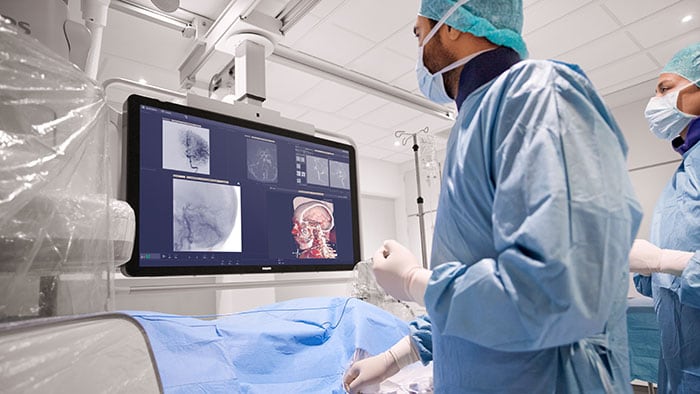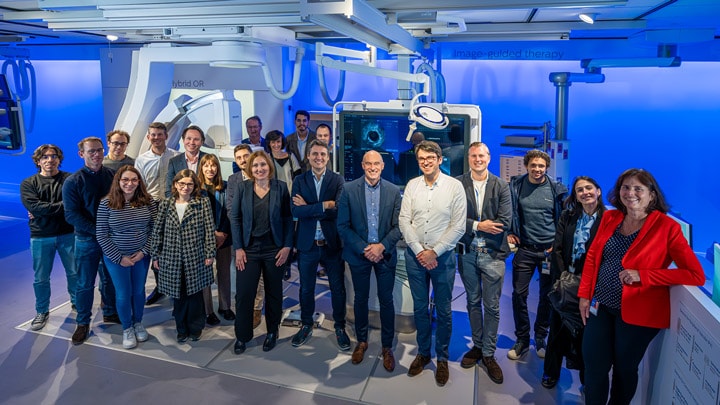At this year’s European Stroke Organisation Conference (ESOC, 4 - 6 May, 2022, Lyon, France), Philips and Nicolab jointly hosted a satellite symposium titled ‘Stroke pathways that clear the way for better outcomes’. Reflecting both companies’ commitment to delivering end-to-end stroke care solutions, the symposium featured four guest speakers who are currently conducting pioneering research into better and faster treatment for a condition where the importance of timely intervention is summed up by the phrase ‘time is brain’.

The future of early stroke detection
Rotem Sivan-Hoffmann MD, Head of the Radiology Department at Meir Medical Center (Haifa, Israel) and founder and Chief Medical Officer at CVAid, gave a presentation on a patient management smartphone app that performs artificial intelligence (AI) assisted video-based stroke triaging. Based on a short video of a patient’s responses to a set of standard questions, the app measures and analyses the degree and reaction time of a suspected stroke victim’s facial muscle movements, communicating the video and analysis results in real time to the neuro team at a stroke center to aid early-stage decision making. Though the solution is works in progress and part of clinical trials, the ability of the app to predict the likelihood that a patient’s stroke is the result of a large vessel occlusion (LVO) may help the emergency department (ED) prepare the appropriate diagnostic testing and therapy. She also described how it could potentially be used in a post-stroke rehabilitation setting to detect frequently occurring secondary strokes.
Clinical value of spectral CT in the neuroradiology ED setting
For diagnostic testing in the emergency department, Ryan K. Lee MD, Chair of the Department of Radiology at Einstein Healthcare Network (Philadelphia, U.S.) highlighted recent developments in the use of spectral CT for stroke diagnosis and treatment selection. Comparing various spectral CT technologies and highlighting the benefits of dual-detector spectral CT technology, like that used in Philips’ Spectral CT 7500 scanner, he illustrated how its ability to differentiate between contrast agent or contrast agent staining and hemorrhaging can be used to aid definitive diagnosis and support treatment decision making.
Getting the clot out fast – new frontiers in stroke workflow and treatment
Jeremy Hofmeister MD, interventional neuroradiologist and artificial intelligence researcher at University Hospital Geneva (Geneva, Switzerland), discussed new frontiers in stroke workflow and treatment for LVO, with the aim of triaging and treating patients in one pass. Analyzing the current Workflow and Goals of Stroke Treatment, he pointed out how StrokeViewer supports the entire stroke team to be seamlessly connected between hospitals, ensuring service is available 24/7 so that patients can receive the right treatment in time. Moreover, highlighting the heterogeneity of LVO blood clots due to the complex interplay of their thrombotic and inflammatory components, he described innovative new AI-enabled blood clot visualization, segmentation, and quantitative measurement tools, as well as new radiomics tools with the potential to predict which patients might benefit from which type of treatment.

Health economics of a 'Direct-to-Angio' suite
Rounding out the symposium, Marc Ribo MD, interventional neurologist at University Hospital Vall d'Hebron, (Barcelona, Spain), gave a presentation on the health economics of the ‘Direct-to-Angio Suite’ approach, in which selected stroke patients move directly from the Emergency Department (ED) to the angio suite without the need for intermediate diagnostic scans. Arguing that improvements CT-like imaging in angio suite now allow more accurate diagnosis to exclude hemorrhagic stroke patient and confirm LVO stroke patients, he presented the results of a study that used a Direct to Angio workflow to reduce 'door-to-groin' time, the time between ED admission and the beginning of a thrombectomy procedure. The study, which was a precursor to the current WE-TRUST multi-center randomized clinical trial, showed the resultant increase in the rate of clinical recovery not only benefitted patient outcomes but also reduced the hospital’s costs to a level at which the return-on-investment for a dedicated stroke angio-suite was less than 3 years.
Philips end-to-end stroke care
Philips’ current end-to-end stroke care solutions for triaging and diagnosis include its Tempus Pro patient monitor for emergency medical service (EMS) use, eConsultant Telestroke solution for emergency department triaging, Spectral CT 7500 scanner for diagnostic imaging, and the Nicolab StrokeViewer for stroke triage and management. For treatment and follow-up, its portfolio includes Azurion platform angio suite solutions for minimally-invasive image-guided therapy, and the Philips BioTel Heart MCOT wearable patch for post-discharge atrial fibrillation (AF) monitoring - a condition often experienced by stroke victims and a high risk factor for recurrent strokes.
To learn more about Philips’ stroke care solutions click here.
To view the Philips-Nicolab ESOC 2022 symposium presentations, click here (paid registration required – available until August 5, 2022).
Stroke care connected
Effective stroke management connects the dots between caregivers at critical moments in stroke care pathways. We're with you, focused on a life saving difference for your patients.
To learn more about Philips’ stroke management click here.
Share on social media
Topics
Contact

Joost Maltha
Philips Global Press Office Tel: +31 6 10 55 8116
You are about to visit a Philips global content page
Continue












